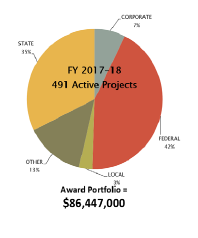You are here
3.1 - Conducting Sponsored Research
HSU conducts a significant amount of externally-funded research for a university of its size, and these research activities generate new innovations, new technologies, and economic benefits to the region. In AY 2017-18 there were more than 180 new research grants awarded to HSU, totaling $28 million.
HSU’s Sponsored Programs Foundation (SPF)—which provides the Humboldt State community with grant contract services and is responsible for administering nearly all external grants to the university—is currently managing 491 active sponsored research grants, totaling over $86 million.
HSU’s research activities attract significant funding to the region and generate over 1,000 local jobs annually. In AY2017-18, SPF managed research activities provided employment for 111 full-time auxiliary staff, 611 part-time staff and faculty, and 342 students.
Beyond these economic impacts, HSU research—which is largely focused on issues related education, natural resources management, energy, and sustainability—leads to the development of new approaches and technologies which directly address the needs of the region and improve the quality of life of its residents.
Figure 7. Active Research Grants (FY17-18)

Some recent examples of such externally-funded HSU research projects include:
- Education: $2.7 million grant from U.S. Department of Education to establish pathways into teacher education programs for Latino and Latina students, helping to meet the critical need for qualified teachers in the region.
- Clean Energy: $5 million grant from the California Energy Commission to develop a cutting-edge microgrid at the Redwood Coast Airport that will generate local renewable energy, strengthen resilience for critical facilities, and provide regional economic benefits. (See Section 3.3 below for details.)
- Wildfires: A series of awards, including a recent grant from the U.S. Bureau of Land Management’s Joint Fire Science Program, to study forest density thinning and other fuel reduction treatments that could increase resilience of forests in the face of climate change, and reduce future damage caused by wildfires, such as those that have recently had devastating impacts on Northern California’s forests and communities.